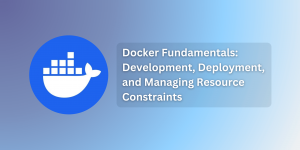REST (Representational State Transfer) APIs (Application Programming Interfaces) are the backbone for communication between software systems in web development. To know the basics of REST API, refer to this blog post: REST API Overview. As developers, understanding key concepts like Pagination, Rate Limits, Data Formats, Filtering, and Error Handling is crucial for designing efficient and user-friendly APIs. In this blog post, we’ll explore these concepts in detail and uncover the best practices for their implementation.
Pagination: Managing Large Data Sets
Pagination in REST API refers to breaking down large data sets into smaller, more manageable chunks called pages. This approach is crucial for improving performance, reducing server load, and enhancing user experience while dealing with an extensive collection of resources. Let’s delve deeper into how pagination works in REST API and explore best practices for its implementation.
How Pagination Works
Pagination involves dividing an extensive data set into pages containing limited resources. Clients can then request specific data pages, typically using query parameters in the API request. Standard parameters used for pagination include:
- Page Number: Specifies the page to retrieve.
- Page Size: Determines the number of items per page.
For example, a client might request the first page of results with ten items per page by sending a GET request to the API endpoint /api/resources?page=1&pageSize=10/.
Upon receiving the request, the API server retrieves the requested data page and returns it to the client as part of the API response. The response often includes metadata indicating the available resources and links between pages.
Best Practices for Pagination
To implement pagination effectively in your REST API, consider the following best practices:
- Limit and Offset: You can implement pagination using parameters like
limitandoffset. The limit parameter specifies the number of items per page, while the offset parameter determines the starting point for fetching data. - Next and Previous Links: Include links to navigate between pages, such as
followingandpreviouslinks in the API response. These links help clients navigate through the paginated data seamlessly. - Metadata: Provide additional metadata in the response, such as the total number of items
(total_count)and the current page number(page_number). This information assists clients in understanding the pagination context.
Here’s an example of how a paginated API response might look:
{
"data": [
// Paginated resources
],
"metadata": {
"totalItems": 1000,
"pageNumber": 1,
"pageSize": 10,
"nextPage": "/api/resources?page=2&pageSize=10",
"previousPage": null
}
}In this example, the API response contains an array of paginated resources (data) and metadata indicating the total number of items, current page number, page size, and links to navigate to the next and previous pages.
Rate Limits: Ensuring Fair Usage and Preventing Abuse
Rate limiting is a mechanism to control the number of requests a client can make to an API within a specified time frame. By imposing limits on request rates, APIs can prevent abuse, ensure fair usage, and maintain system stability.
Types of Rate Limiting
There are several approaches to implementing rate limiting in REST APIs:
- IP-based Rate Limiting: Limit requests based on the IP address of the client. This approach is practical for controlling access to public APIs but may need to be more suitable for clients behind NAT (Network Address Translation) or proxy servers.
- Token-based Rate Limiting: Assign tokens to clients upon authentication and decrease the token count with each request. Once the token count reaches zero, the client must wait until the tokens are replenished or the rate limit resets.
- User-based Rate Limiting: Associate rate limits with individual user accounts or API keys. This allows for more granular control over usage and enables differentiation between authenticated users.
Here’s an example of how rate limit information might be included in an API response:
HTTP/1.1 429 Too Many Requests
Content-Type: application/json
X-RateLimit-Limit: 100
X-RateLimit-Remaining: 0
X-RateLimit-Reset: 3600
Retry-After: 60
{
"error": {
"code": "rate_limit_exceeded",
"message": "Rate limit exceeded. Please try again later."
}
}Best Practices for Rate Limits:
1. Set Reasonable Limits: Determine appropriate rate limits based on server capacity, expected traffic, and API usage policies. Strike a balance between allowing sufficient requests for legitimate users and preventing abuse.
2. HTTP Headers: Communicate rate limit information to clients using HTTP headers like X-RateLimit-Limit, X-RateLimit-Remaining, and X-RateLimit-Reset. These headers inform clients about their current usage status and when they can make additional requests.
3. Graceful Handling of Exceeding Limits: Handle cases where clients exceed rate limits gracefully by returning appropriate HTTP status codes (e.g., 429 Too Many Requests) and error messages. Guide how clients can adjust their request rate to comply with the limits.
Filtering: Refining Your Data Retrieval
Filtering in a REST API allows clients to retrieve a subset of resources from a collection based on specific criteria. This feature enhances the flexibility and usability of the API by enabling clients to narrow down their search results according to their requirements. Let’s explore how filtering works in REST API and discuss best practices for its implementation.
How Filtering Works
Filtering in a REST API typically involves specifying query parameters in the API request to define the criteria for selecting resources. These query parameters can represent various attributes or properties of the resources, allowing clients to filter based on specific conditions.
For example, consider a REST API that provides a collection of products. Clients can filter the products based on attributes such as category, price, availability, or any other relevant criteria. Clients include query parameters in the API request to specify their filtering preferences, and the API server processes the request accordingly.
Common Filtering Techniques
There are several standard techniques for implementing filtering in REST APIs:
1. Query Parameters: Utilize query parameters in the API request URL to specify filtering criteria. For example, /api/products?category=electronics retrieves all products in the "electronics" category.
2. Logical Operators: Support logical operators such as AND, OR, and NOT to create complex filter expressions. For example, /api/products?category=electronics&price=less_than_100 retrieves products in the “electronics” category for less than $100.
3. Comparative Operators: Allow clients to use comparative operators such as equals, less than, greater than, etc., to define filter conditions. For example, /api/products?price_greater_than=50 retrieves products with a price greater than $50.
4. Partial Matching: Support partial matching for text-based filtering. For example, /api/products?name_contains=laptop retrieves products with the term "laptop" in their name.
Best Practices for Filtering
To implement filtering effectively in your REST API, consider the following best practices:
1. Consistent Query Parameter Names: Define clear and consistent query parameter names for filtering criteria. Use descriptive names that reflect the attributes being filtered.
2. Document Filtering Options: Provide comprehensive documentation for the supported filtering options, including available query parameters, their syntax, and usage examples. This helps developers understand how to use filtering effectively.
3. Use Indexing: Optimize database queries by indexing fields commonly used for filtering. Indexing improves query performance and reduces response times, especially for large datasets.
4. Limit Results: Implement pagination alongside filtering to limit the number of results returned per request. This prevents clients from overwhelming them with large response payloads and improves performance.
Here’s an example of how filtering might be implemented in a REST API request:
GET /api/products?category=electronics&price_less_than=500 HTTP/1.1
Host: example.comIn this example, the client requests products from the API filtered by the “electronics” category and a price less than $500.
Data Formats: Choosing the Right Representation
REST APIs support various data formats representing resource representations, such as JSON (JavaScript Object Notation) and XML (eXtensible Markup Language). The choice of data format can impact factors like readability, performance, and compatibility with client applications.
Best Practices for Data Formats:
1. JSON as the Default: You can prefer JSON as the default data format for REST APIs because it is lightweight and human-readable. JSON is widely supported across programming languages and platforms, making it an ideal choice for interoperability.
2. Support Content Negotiation: Implement content negotiation mechanisms to allow clients to specify their preferred data format (e.g., JSON or XML) using the Accept header in the request. This enables flexibility and ensures compatibility with a diverse range of client applications.
3. Consistent Data Structure: Maintain a consistent and well-defined data structure across API endpoints to facilitate clients’ ease of understanding and consumption. Use clear naming conventions and adhere to industry standards for representing resources and their attributes.
Error Handling: Handle Errors Gracefully
Handling errors effectively in a REST API is crucial for providing clients with a reliable and user-friendly experience. Errors can occur for various reasons, including invalid input, authentication failures, server-side issues, or resources not found. Proper error handling ensures clients receive clear and informative responses, enabling them to understand and address issues efficiently. Let’s delve into the best practices for handling errors in REST APIs.
Best Practices for Error Handling
- Use Appropriate HTTP Status Codes
HTTP status codes provide a standardized way to communicate the outcome of a request. Use status codes to indicate the nature of the error:
- 200 OK: Successful request.
- 400 Bad Request: Invalid request syntax or parameters.
- 401 Unauthorized: Authentication is required and has yet to be provided.
- 403 Forbidden: The client cannot access the requested resource.
- 404 Not Found: The requested resource does not exist.
- 405 Method Not Allowed: The HTTP method is not supported for the requested resource.
- 429 Too Many Requests: Rate limit exceeded.
- 500 Internal Server Error: Generic server-side error.
- 503 Service Unavailable: The server cannot handle the request due to temporary overloading or maintenance.
- Include Descriptive Error Messages
Alongside HTTP status codes, provide informative error messages in the response payload. The message should clearly explain the reason for the error and suggest actions to resolve it. Ensure consistency in error message formats across the API to facilitate client-side error handling.
- Handle Uncaught Exceptions
Ensure that uncaught exceptions are caught at the appropriate level in the application stack. Log detailed error information for debugging purposes and return a generic response to the client to avoid leaking sensitive information.
- Document Error Responses
Comprehensive API documentation should include information about potential error responses, including the corresponding HTTP status codes, error messages, and possible causes. Clear documentation helps developers understand how to handle errors gracefully.
Conclusion
In REST API development, concepts like Pagination, Rate Limits, Data Formats, Filtering, and Error Handling are pivotal in shaping API’s performance, usability, and scalability. By implementing best practices, the developers can create APIs that are efficient, user-friendly, and resilient to abuse. As you embark on your API development journey, remember to consider these concepts and the best practices carefully to deliver high-quality APIs that meet the needs of your users and applications.
At Knowi
To learn about REST API basics, read our blog post here: REST API Overview and 4 Ways of REST Authentication. An example of a data analytics tool that supports REST APIs natively is Knowi, a unified analytics platform. You can join your REST API data with data from other applications, SQL or NoSQL databases, flat files, and more. You can then use the dashboard and widget features to build custom visualizations that simplify your data and make them presentable. Still trying to understand? Book a demo today with Knowi and embark on a transformative analytic






